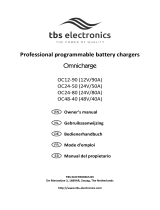3
Notice of Copyright
Omnicharge Solar 60-70A MPPT Solar Charge Controller installation manual © 2023 TBS Electronics
BV. All rights reserved. No part of this document may be reproduced in any form or disclosed to third
parties without the express written permission of TBS Electronics BV, De Marowijne 3, 1689AR,
Zwaag, The Netherlands. TBS Electronics BV reserves the right to revise this document and to
periodically make changes to the content hereof without obligation or organization of such revisions
or changes, unless required to do so by prior arrangement.
Exclusions for documentation and product usage
UNLESS SPECIFICALLY AGREED TO IN WRITING, TBS ELECTRONICS BV (“TBS”) :
1. MAKES NO WARRANTY AS TO THE ACCURACY, SUFFICIENCY OR SUITABILITY OF ANY
TECHNICAL OR OTHER INFORMATION PROVIDED IN ITS MANUALS OR OTHER
DOCUMENTATION
2. ASSUMES NO RESPONSIBILITY OR LIABILITY FOR LOSSES, DAMAGES, COSTS OR EXPENSES,
WHETHER SPECIAL, DIRECT, INDIRECT, CONSEQUENTIAL OR INCIDENTAL, WHICH MIGHT
ARISE OUT OF THE USE OF SUCH INFORMATION. THE USE OF ANY SUCH INFORMATION
WILL BE ENTIRELY AT THE USER’S RISK
3. REMINDS YOU THAT IF THIS MANUAL IS IN ANY LANGUAGE OTHER THAN ENGLISH OR
DUTCH, ALTHOUGH STEPS HAVE BEEN TAKEN TO MAINTAIN THE ACCURACY OF THE
TRANSLATION, THE ACCURACY CANNOT BE GUARANTEED.
4. MAKES NO WARRANTY, EITHER EXPRESSED OR IMPLIED, INCLUDING BUT NOT LIMITED TO ANY
IMPLIED WARRANTIES OF MERCHANTABILITY OR FITNESS FOR A PARTICULAR PURPOSE,
REGARDING THESE TBS PRODUCTS AND MAKES SUCH TBS PRODUCTS
AVAILABLE SOLELY ON AN “AS IS” BASIS.
5. SHALL IN NO EVENT BE LIABLE TO ANYONE FOR SPECIAL, COLLATERAL, INCIDENTAL, OR
CONSEQUENTIAL DAMAGES IN CONNECTION WITH OR ARISING OUT OF PURCHASE OR
USE OF THESE TBS PRODUCTS. THE SOLE AND EXCLUSIVE LIABILITY TO TBS, REGARDLESS
OF THE FORM OF ACTION, SHALL NOT EXCEED THE PURCHASE PRICE OF THE TBS
PRODUCTS DESCRIBED HERE IN.
Document name, date and part number
“OCS-60-70 Installation Manual Rev1endfs”, August 2023, xxxxxx





















